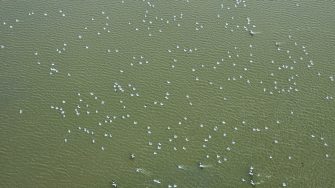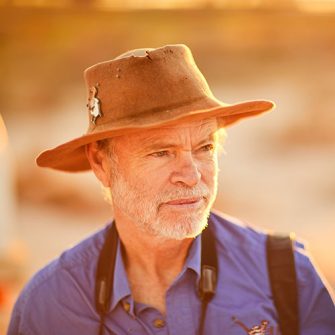
Date: Tuesday October 31st 2023
Project: Eastern Australian Waterbird Survey
Observers: Richard Kingsford (UNSW), John Porter (NSW DPE)
Trainee: Shelley Thompson (MDBA), Simon Toop (Vic GMA)
Pilot: Thomas Clark
Today we ran down the River Murray from Wentworth, past Renmark, Loxton and on to Berri, surveying the Riverland and then on to survey the two Lower Lakes, Lake Alexandrina and Lake Albert. It is always a spectacular run and surprisingly was not too windy today. Always a bonus.
Surveying the main channel of the River Murray
We probably saw more waterbirds along the main channel of the river than we have previously seen. This probably reflected the shallowness of floodplains providing a lot of food as they dried out. There were many fish-eating birds, particularly cormorants and pelicans.
Surveying waterbirds along the River Murray
One of the areas drying back was along Frenchmans Creek which flows into Lake Victoria, with many of the flooded channels and floodplains drying back compared to last year. There was still good areas of habitat along this system.
Surveying Frenchmans Creek, a distributary system of the River Murray
There was a lot less water around this year, with the water confined primarily to the main channels and the wetlands. Out on the Chowilla floodplains, you could see where the environmental flows had filled some of the wetlands, providing habitat for hundreds of waterbirds.
Surveying the wetlands on the Chowilla floodplain of the River Murray
There must be lots of fish in the rivers and the wetlands of the River Murray today. There were big flocks of cormorants and pelicans all along the River Murray.
One of the large pelican flocks feeding on the main channel and wetlands of the River Murray
The two large freshwater lakes at the mouth of the River Murray are extensive. We surveyed the northern shoreline of Lake Alexandrina first.
Coming in to do our first survey on Lake Alexandrina
We were surprised at how few ducks there were on the two lakes. There were plenty of cormorants, mostly Great Cormorants but also good numbers of Pied Cormorants and also Little Black Cormorants and Little Pied Cormorants. There were a few flocks of hundreds of Black Duck, Australian Shelduck and Grey Teal and also pockets of Hardhead. There were hardly any swans. Often these two lakes have thousands of swans. Not today. A few were breeding but nothing like the numbers we have seen in the past.
Tomorrow we head down the Coorong and do our second count on the two lakes.

